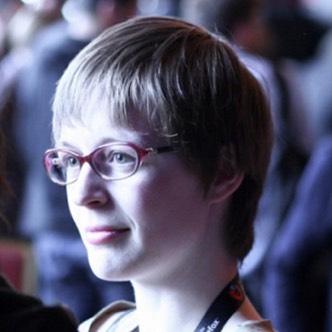Monday Profile: Rachel Ilan Simpson
 This week’s Monday profile is Rachel Ilan Simpson: UX Designer on the Chrome team.
This week’s Monday profile is Rachel Ilan Simpson: UX Designer on the Chrome team.
If you’ve seen our Scroll magazine, you’ll have noticed we included interviews with all of our Respond keynote speakers – except Rachel.
We did do an interview with Rachel, but for logistical reasons we weren’t able to include it in Scroll. We hope you enjoy it.
Rachel Ilan Simpson: In Person
Q Describe your family
I grew up in Calgary, in central Canada. I come from a large family, who all do a lot of different things. Some of my family has spread to different parts of the world. My parents moved to Perth in Australia, although they may move back to Canada. My younger brother still lives and works in Calgary. I live and work in Munich, in Germany.
Q What book has changed your life in some way?
A This is hard to answer because it’s hard to choose just one book. Steve Krug had a big effect on me. His second book, It’s Not Rocket Surgery, in particular, helped me to think about user testing in a different way, that while it might sometimes be difficult to set up – organising people in a room and monitoring them – it’s always worth doing and is the only real way to test. It helped me to understand the importance of user testing, and that’s stayed with me.
I’ve also been influenced by books I’ve read for pleasure. I’m a real geek in that I get into fantasy and science fiction books. I’ve read all the Harry Potter, Game of Thrones books … I really enjoy science fiction and fantasy, books that have characters who question how their world works, who get placed into situations they have to get out of, who react against authority, and who might use technology to do that, especially young people.
Q What formal qualifications do you have? How did you end up doing web work?
A I have an Industrial Design degree from Emily Carr University in Vancouver. I spent one semester as an exchange student at the Hochschule für Gestaltung (College of Design) in the southern German town of Schwäbisch Gmünd, studying interaction design. I also had two weeks at Mimar Sinan Fine Arts University in Istanbul and two weeks at the Design School Kolding, in Denmark.
I’d spent a lot of time as a teenager making websites, and after I graduated I worked with different design agencies, and then an interactive design company called Mod7 – they do a lot of web design, make games and applications, that kind of thing – and that’s how it all started.
Q Describe what you do. What’s your job? Is presenting at web conferences part of that job?
A I work for Google, I work on the Google Chrome team and we do a lot of different things. My job starts with research and ends with implementation – we conduct a lot of studies with folks to understand how they’re using the internet and Chrome itself, and from there we think about the insights: what we can improve on, what we can develop, looking at both long term structural improvements as well shorter term feature development.
I think a lot about impact. I was talking last night with some people with whom I’ve been running a Design Jam in Munich for four years and we frame all of our briefings for the event around impact, and that means either it helps a lot of people – many people around the world – or a smaller number of people but in a very big way, it has a big impact on their quality of life. That’s what I care about in terms of what I want to do, and Chrome in particular achieves a lot of things that I want to see achieved.
It’s an open ecosystem, and that’s something that’s really important to the team, supporting the open web ecosystem, because it’s secure and high quality and fast. We’re now working toward equality of access so we’re thinking a lot about people in emerging markets and how to make the web better for them, which is a very complex challenge because you have to think about balancing the needs of people who have very limited access with people who have what we would consider normal access, which is excellent access.
Q Do you give much thought to the title you apply to yourself? Does it matter?
A I don’t know that it matters too much in the context of my work today but I think it does matter in terms of how you frame people’s expectations around your work. User experience, interaction, information architecture … I don’t know that that’s so important to me at the moment, but I think in the longer term, framing for design within companies like Google, thinking about how we describe ourselves matters.
So the answer is: kind of.
Q Describe the first time you gave a presentation on a web topic (or related). How did it come about? Did you feel nervous or confident? Any props? Did it all go smoothly? How was it received? What was your own immediate reaction afterwards?
A It was a talk on design at the Women Techmakers event here in Munich, where we bring together women in professional fields to talk about technology and also obviously try to push forward ideas around diversity and that kind of thing. It was a super interesting group to talk to. I actually don’t do many “women in tech” events, but it was really an interesting experience.
The talk itself was pretty straightforward, I talked about different kinds of design processes – ones that I’d been involved with or knew of – and how people can bring them into their own work. It was a nice talk to put together.
But the interesting part was the conversations afterwards, where we talked a lot about important topics for women in technology at the moment. For example, we talked about the importance of having senior male mentors, challenges we face, working with web standards, building networks, a whole range of topics.
Q In The Graduate, Mr McGuire has just one word to say to aimless college graduate Benjamin Braddock: “Plastics”. What one word would you give to today’s prospective web professional?
A I’ll provide a bit of context, first. At my university and, I think, a lot of universities, students complain about not being taught concrete skills – and I think that’s a valid complaint. Not being taught how to use Photoshop, for example, was a big complaint when I was learning. But I’ve benefited a lot because my school focused on critical thinking.
So I think “critical thinking” – it’s two words, but “critical thinking” would be what I’d say. As design gets more of a seat at the table – and it has – designers become more responsible, as we’ve always wanted, not just for the skin but for the strategy, the user experience, the business itself, and the complexity of these topics … I mean, I would never argue that business strategy is more complex than visual design. Visual design itself has a strategy that is complex, but more and more designers need to be able to articulate their ideas, their planning … things that may be outside our field of comfort.
When I look at resumes and people and whether I want to hire them, we’re not just looking for great technical skills, we’re also looking for why they’re making the choices they’re making, why are we criticising customers and users, why are we building immediately what should be in experimental mode.
So, yes. Critical thinking.
Like to watch and read more like this? Be the first to score invitations to our events? Then jump on our once a week mailing list where we round up the week’s best reading and watching on all things Web. And you’ll get a complimentary digital copy of our Scroll magazine.
Great reading, every weekend.
We round up the best writing about the web and send it your way each Friday.
